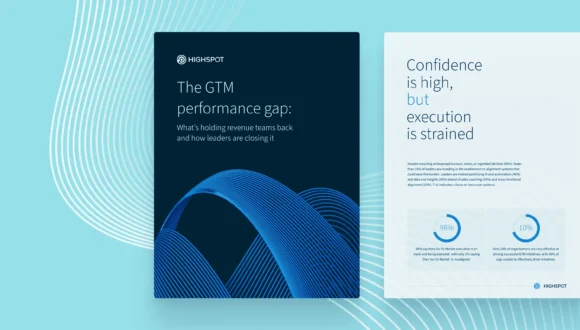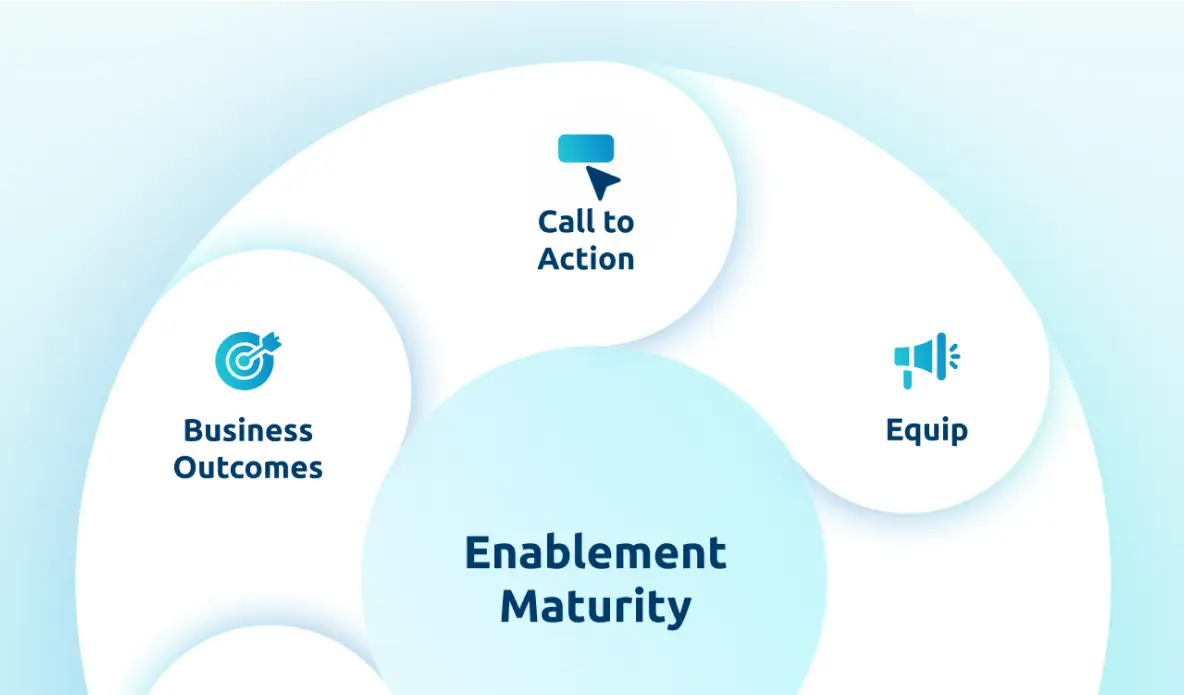According to the State of Sales Enablement Report 2024, 20% of organizations see sales process as a key strategic priority. So how can you streamline your sales process and equip reps to win more and win faster?
Shawnna Sumaoang: Hi, and welcome to the Win Win podcast. I am your host, Shawnna Sumaoang. Join us as we dive into changing trends in the workplace and how to navigate them successfully.
Here to discuss this topic is Scott McNabb, the chief sales officer at Verisk Marketing Solutions. Thank you for joining us, Scott. I’d love for you to tell us about yourself, your background, and your role.
Scott McNabb: Yeah, I’m thrilled to death to be here. Thank you so much. As mentioned, I’m the Chief Sales Officer for Verisk Marketing Solutions.
I have been in and around the world, solving problems for major brands, major carriers, major tech companies, et cetera, for the better part of the last 20 years, so since I was nine years old, that’s a joke, and have been leading sales teams, both in the data world and also in the SaaS software world over the course of my career.
SS: Amazing. Well, Scott, we are honored to have you here. Given your extensive experience as a sales leader, you have seen the landscape evolve. I’m sure throughout that journey, but especially in recent years. What are some of the top challenges that you would say sales teams face today?
SM: You know, I would say as relates to my use of different tools in the sales cycle, what I continue to evolve and learn from is the notion that sellers may not understand analytically where a Buyer stands in their buyer’s journey.
And it’s evidenced by the fact that, again, going back to the conversational topic, they don’t know the right material to provide to the right buyer at the right time that might resonate with them at the proper deal stage, more importantly, at the proper. Sort of category of ICP, right? The ideal customer profile.
So sending the wrong material to the wrong buyer at the wrong time in the stage, and before you know it, you get lost in the deal cycle. And it is the number one challenge that sellers face, both in my current role and in previous companies that I’ve worked with is understanding where they are from a situational awareness perspective in the deal sort of cycle. I’ve got a military aviation background, and one of the things that we teach in fighter pilot school is helping the aviator understand where they are in the fight at any given moment, right? Where’s the nearest, you know, fuel stop? Where’s the enemy line versus the friendly line? You know, where do you stand three-dimensionally in relation to the buyer?
In this particular example, but in relation to the enemy, you know, am I positioned properly to either fight and win or escape and save myself for another day? So to use the vernacular, that situational awareness is something that we teach in, you know, in our aviation community. And it’s a construct situational awareness is a construct that we try.
To guide, teach, coach, and sort of replicate for the sellers so that when they’re in the deal cycle, that they understand where they are in relation to the challenge that the buyer faces. Does that make sense?
SS: Absolutely. And I have to say, Scott, also very cool that you are in the aviation space. That is amazing.
SM: It’s 15 years of my life, lots and lots of time doing it, and it’s amazing the corollaries between that situational awareness, the thing that you have to teach, and oftentimes young up-and-coming aviators, they get that they’re flying the plane, and they get that it’s moving in a forward direction, and they get what they have to do to get from here to there, do the thing you have to do, and return safely. But, you know, sort of advanced instruction is understanding three dimensionally where you fit in the fight.
SS: I can see how that is a great analogy to sales. Now, from your perspective, how can enablement help sales teams overcome some of these challenges to achieve more success?
SM: Well, let’s be clear. So there’s training and there’s enablement.
I think we get these two things confused. Training is what you do when you’re trying to show somebody how to lift in the gym, right? Enablement is when they’re thinking from a, again, three-dimensional perspective when we’re guiding them to have critical thinking skills and understand if I’m here, then my next move is there, and we call it in our world, next best action.
We built our entire sales enablement model around MBAs and the most often reasons why sales reps won’t put deals and commit is because of the fear that if I asked you to commit, or if you’re willing to stick your neck out and commit to a deal, Then somebody is going to ask you to have a plan for how you’re going to execute on the mission.
Right? And so it is the number one challenge. They say that I learned this from an amazing sales leader. Light is the world’s best disinfectant, right? So enablement is about bringing deals into the light and via example, leading from the front, guiding, coaching. Enablement is not something that lives exclusively in an enablement department.
It is something that is truly something that is to be led by the leaders. They have to exhibit and exemplify these skill sets so that the seller will feel as though we’re all in the same set of airplanes after the same mission. And so enablement. Is that guidance tool, but again, it’s not the enablement department exclusively.
It is the seller, the sales leaders function. This is what, uh, I’ve got a sales leadership summit next week in Chicago with all my leaders and a big part of what I’m coaching on is how do you coach and enable your sellers? You can’t just depend upon the enablement department to solve for the challenge.
SS: I love that. You’ve essentially made enablement a cultural priority across your organization. And I know that you’re passionate about developing high performance cultures. What are some of your best practices for building that culture within a sales team?
SM: They say that culture eats strategy for breakfast. It’s an old school book that’s been around for 30 years and it’s still never more true. And so culturally we have to guide the sellers from a culture perspective. Around the notion of franchise ownership, right? They have to own, understand the mission, be clear on the goals, be clear on the steps, and then accountability comes with culture.
So again, a big part of what we’re teaching next week is really just sort of an agreement between the sales leader and the sales rep on what is accountability and what does that mean, and then finally, Culture, whereby our one on ones are designed around four key concepts. Revenue first, right?
Where you stand in the revenue picture, people, right? What people are you struggling with process? What processes are kicking your butt? And then finally innovation, right? Where we make it the responsibility of everybody culturally in the sales team to constantly be looking for ways to improve and innovate our process, right?
So it’s just not do it because I say that you do it. They have to be bought into that concept. And more importantly, they have to be challengers who look at the process and go, all right, well, look, that’s kicking my butt. That’s stupid. Why are we doing it that way? I got an idea. Why don’t we do it this way, because we can shave three days off of the opposing cycle, or we can accelerate our deals because finally, culturally, it’s all about velocity of deals.
Culture has to be sort of digging in on the notion of increasing the velocity at which we move deals through the cycle. Because, you know, they say an army travels on its stomach, a sales team travels on velocity.
SS: I could not agree more. So we talked in the intro and you mentioned it just now about the importance of a solid sales process.
How can the sales process influence a high-performance culture? And what have you done to streamline the sales process to help kind of boost sales performance?
SM: I love the question. Look, I think first and foremost, there’s a massive change around this notion of servant leadership. So it’s important that we start backwards from the challenge, which is a high-performing sales organization.
It’s funny. 10 years ago, servant leadership was not in vogue and as our sales teams have grown up, and we have Gen Z and we have Gen X and, and et cetera, all of a sudden they come from worlds where maybe they were not guided and coached the proper way. So weirdly enough, serving our teams, serving to the people that we were responsible for is back in vogue all of a sudden.
So I think that step one is let’s make sure that we start with the servant leadership methodology. Two, I think it’s remarkably important that we pivot our sales model from a sales-led model to a customer-driven model, right? Our sales processes historically have been, where do you think you are in the deal?
I’m at stage three, which means that I’m going to push them to do a thing. And then stage four, I’m going to hand them, these are the things that we do to manage our process. Whereas switching to a buyer-centric methodology, which is if I call the customer and ask them questions about where they are in their buying cycle, stage four, stage three, stage five, would the customer say that’s where I am in my process for acquiring the thing that you sell, right?
So switching to a customer centric model away from a sales centric model, this still exists and pervades. All over the industry, when it comes to sales organizations, we’re tracking where you think you are in the deal. I want to know, where do you think the customer thinks they are in the buying cycle? If that resonates with you.
SS: Oh, it absolutely does. And from your perspective, what would you then say is the strategic advantage that an enablement platform provides for improving the sales process?
SM: All right, I’m going to go back to situational awareness. Sorry. At the end of the day, it helps the seller know more about where the customer is in their buyer’s journey.
Whereas in the old days, we would just, you know, enablement wise, we’d send out stuff and, you know, I wouldn’t even know necessarily what they’re looking at or what they’re engaging with or what of my content resonates with them. But with an enablement platform, and I’ve used your platform in. Now, this is my third company and purchased it in two previous companies.
You know, I find that it’s a game changer because you’re competing in a world whereby many don’t have this thing and therefore the seller is blind. Again, going back to the military flying example, there’s a notion called no joy, which means when I’m looking for the enemy and I can’t find them. On the radio, you click off no joy, which means I don’t have sight of where this guy is.
This human that is my adversary. These kinds of tools provide the seller with that no joy moment where they go. All right. I do know exactly where they are. They’re 300 feet below me. They’re there at this speed and this course. And the enablement tool is a, for lack of a better term, it’s a game changer for knowing where The customer is and where I as a seller can make better decisions about where they are in their buyer’s journey down to the point of this materials not resonating.
I sent the wrong stuff at the right time. In my current company, we use our enablement tool for both sales and CSMs and our solutions consultants and our marketing team, obviously to replace SharePoint so that we not only I can see as a leader. What’s working? What’s not? Where are they using? What pieces of content and what stage of the buyers journey?
Wrong time, wrong content, wrong message, et cetera. So now I’ve got analytical knowledge on why is the deal stalling in stage, right? So I can run analytics out of salesforce that goes, all right, you’re in stage four. We’ve shipped over a raft of content, but why is the deal, why is it not resonating with the buyer at this stage in the journey?
Let’s go backwards a step and figure out what did we miss and let the data then tell us and analytically help us understand where are we stalling in deals. And what’s causing a velocity change? You get what I’m saying?
SS: I do. I love that data-driven approach. How do you leverage data? If you have a few examples to refine and optimize the sales process?
SM: Well, look, I think it comes down to and sorry, I’m going to go off track just two seconds, but know that I feel like that present company excepted. I have led sales leadership teams before where they were managing using analytics as a crutch. Instead of trying to understand what’s going on, we’re managing to the metrics.
Activity wise, instead of managing to the metrics again around velocity around understanding what pieces of content resonates best, we’re using analytics the wrong way. In my opinion, accountability. Yes, but activity for activity sake. No, right? Can’t work that way anymore. So the less mature sales leaders are the ones that are basically sitting behind the steering wheel, looking at analytics to give them a false sense of security.
Right. We got to take the analytical information and help us understand and make better decisions about what’s working in the deal cycle. Why are things not progressing? Where are things stalling? Let’s get a better picture about the deal cycle and not just lean on old school metrics. You know, email open rates and click through rates – they don’t tell me anything. It’s a vanity metric, right? Understanding how many sales meetings that they had this week, while that is a core metric for activity, it doesn’t really tell me the quality of the meetings that you’re having, right? That’s what I care about. Yes, I certainly want you making the dials and I want you making the connections, but what I care most about is that Those amazing interactions with the buyers are turning into a valuable velocity change in the deal cycle.
SS: I love that. And I know that all of that data is helping to inform a lot of the innovation that’s coming out of AI. And I know that AI sales tactics are an area of interest to you. I’d love to hear directly from you. How do you plan to leverage innovation like AI to improve the sales process and the performance of your teams?
SM: Again, great question. Timely topic. Obviously, at the beginning of that journey is where I would say that we are, but just getting sellers to use AI to even sort of have it guide them on what conversation would resonate with the buyer at this stage. With this problem, it’s really not about AI. If you think about it, it’s about building a library of AI prompts, because I find that the reason why sellers don’t use AI is not because they can’t figure out how to ask a question they’re asking the wrong.
Questions of the AI engine, and then they’re surprised when they get a really, you know, stupid or flat line answer from the AI tool. It’s not the AI tool’s fault. It’s we’re asking the wrong question. So what I’ve asked my enablement team to do is build and load into my enablement platform a library of AI prompts that will provide the proper response.
SS: I love that. I think that’s phenomenal. Scott, last question for you. If you could give other sales leaders who are looking to improve their sales process one piece of advice for the year ahead, what would it be?
SM: You know, I think it’s impossible for me to give one piece of advice, but I think the predominant one is be a servant leader first, right?
Have the team that you support. Accountability comes with servitude, right? So if we’re serving the teams that we’re supporting, then they will feel supported and guided and coached. If you’ve ever worked for a company that does not espouse the notion of servant leadership and is the opposite of that, which is often known as top-down leadership, then you don’t feel very supported and you’re not pulled Up, right?
Servant leadership, I think, is back in vogue because people weren’t feeling guided and coached and pulled, right? It’s, I’m going to stand on you for what you’re not doing, but not guide you on what you could be, what’s possible to be done. And so that’s, if anybody asked me, that’s my number one thought is start backwards from servant leadership and Okay.
Get really amazing at guiding, coaching, teaching, leading from the front. You know, it’s the old-school model. I never am going to ask anybody to do something that I wouldn’t do myself. That’s an old school military term, but at the end of the day, it still works. Still works like a dream.
SS: Absolutely. Scott, thank you so much for sharing your advice with our listeners today. I greatly appreciate the time.
SM: It’s my pleasure. Good luck, everybody.
SS: To our audience, thank you for listening to this episode of the Win Win Podcast. Be sure to tune in next time for more insights on how you can maximize enablement success with Highspot.






